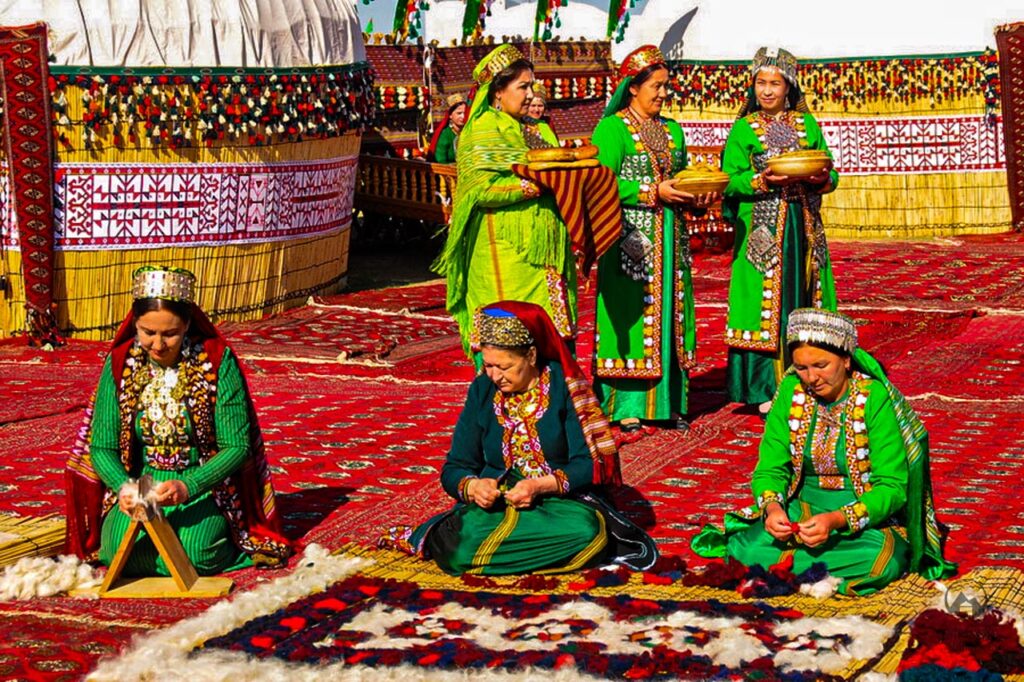Turkmenistan culture and traditions
Turkmen culture
Turkmenistan has a rich and diverse culture that has been shaped by its history and geography. The country’s unique blend of nomadic, Central Asian, and Persian influences has created a rich and diverse cultural combination. One of the key elements in Turkmen culture is a nomadic heritage: Turkmenistan has a long history of nomadic society, and this heritage is reflected in many aspects of the country’s culture.
Turkmen people have a strong connection to their horses, and horsemanship is considered a symbol of prestige and bravery. This nomadic heritage is also reflected in traditional clothing, which often features long, flowing robes and hats, and in the use of portable tents for shelter.
Since independence, the state-building programme of Turkmenistan has set a major focus on the rise of the traditional culture of the Turkmen people. Turkmen-style dress, for instance, is required to be worn by most school and university students and teachers, and especially in government offices. Television channels show frequent concerts of Turkmen music, based around the two-stringed dutar and a guttural singing style.
The Turkmen carpet, Ahal Tekke horse and the poetry of Magtymguly are all celebrated in national holidays. Traditional dances such as the energetic gush depdi from the western Balkan Region have been adapted to fit large state concerts. Turkmen culture is best enjoyed during our Turkmenistan Tours or Central Asia Tours including Turkmenistan.


Turkmen Cuisine
Turkmenistan cuisine reflects in its people that has a blend of its nomadic past, ethnic Turkmen majority, and Uzbek, Russian and Tajik minorities. Turkmen cuisine is piled high with meat, rice, sour milk products, cereals, vegetables, cheeses and butter made from camel’s milk. A distinctive feature of Turkmen cooking is preserving the original flavors of the ingredients and not covering them with intense herbs and spices.
Turkmen Dance and Music
Music and dance play a big role in Turkmen culture. Traditional music is characterized by the use of instruments like the dutar (a long-necked lute), the gijak (a three-stringed fiddle), and the tekemend (a type of hammered dulcimer). Turkmen dance is also an important part of the country’s cultural heritage and includes the levendi (a male dance) and the goychak (a female dance).
Turkmen Dance
Turkmenistan dances in Turkmenistan are influenced by the country’s nomadic lifestyle, and they often feature intricate footwork, lively rhythms, and colorful costumes.
Turkmen Music
Turkmenistan’s music has a rich history that dates back to ancient times. It is heavily influenced by the country’s nomadic traditions and cultural exchanges with neighboring countries, such as Iran and Afghanistan.
Turkmen Traditions
The current terretory of Turkmenistan has been mainly a land of Turkmen nation since the eighth century C.E, despite that the land was a home to a number of nomadic peoples. Along their history, Turkmen survival has rested squarely with the clan and extended family.
The Turkmen’s sense of identity still comes from tribal ties. These ancient tribal loyalties established strong enough to resist Soviet attempts to destroy them, and the solid devotions to as well as value for family remain firmly entrenched. Turkmens are very traditional and have strong connections with livestock and animal agriculture.
Traditional Turkmen Clothing
Traditional clothing in Turkmenistan is distinguished by its brightly colored and intricately embroidered designs.
The clothing is heavily influenced by the country’s nomadic heritage and reflects its rich cultural heritage.
Turkmen Handicrafts
Turkmenistan is famous for its traditional handicrafts, including carpet weaving, metalwork, ceramics, and textiles. These crafts are often passed down from generation to generation and are considered a significant part of the country’s cultural heritage. Turkmen carpets, in particular, are known for their intricate designs and high quality.
Turkmen Wedding
Turkmen people place immense significance on weddings as they represent the continuation of community life and the dominance of family in society by symbolizing the marriage of their children. Turkmen culture traditionally consists of large families and weddings provide an opportunity to reunite with relatives who live far away,
Akhal-Teke Horse
Akhal-Teke is a famous horse breed admired for its speed, intelligence and strength in long hikes and is also the pride of all Turkmen. Akhal Teke horses have been honored in Turkmen’s traditional songs, proverbs and poems and their intellect, wisdom and devotion to human beings are all legendary
Turkmenistan Festivals
Festivals in Turkmenistan play a significant role in preserving the nation’s heritage and traditions. They serve as opportunities for communities to gather, share stories, and pass down skills to future generations. These celebrations provide a unique glimpse into the Turkmen way of life, blending ancient customs with modern expressions of national pride.
See also Kyrgyz, Kazakh, Uzbek and Tajik cultures
Page updated 2.2.2023